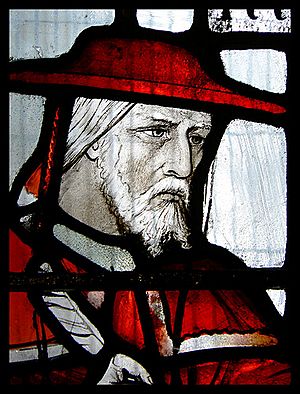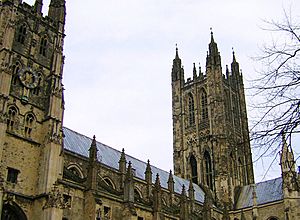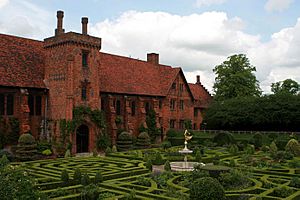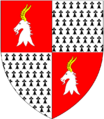John Morton (cardinal) facts for kids
John Morton (born around 1420 – died September 15, 1500) was an important English church leader, lawyer, and government official. He lived during a time of great change in England, known as the Wars of the Roses. Morton served three different kings: Henry VI, Edward IV, and Henry VII. He held many powerful positions, including Bishop of Ely, Lord Chancellor, and Archbishop of Canterbury. Later, he became a Cardinal, a high-ranking official in the Catholic Church.
Quick facts for kids His Eminence John Morton J.C.D. D.C.L. |
|
|---|---|
| Cardinal, Archbishop of Canterbury Primate of All England |
|
 |
|
| Church | Roman Catholic |
| Appointed | 6 October 1486 |
| Reign ended | 15 September 1500 |
| Predecessor | Thomas Bourchier |
| Successor | Thomas Langton (as bishop-elect), Henry Deane as true Archbishop |
| Orders | |
| Consecration | 31 January 1479 by Thomas Bourchier |
| Created Cardinal | 20 September 1493 |
| Rank | Cardinal priest of Santa Anastasia |
| Personal details | |
| Born | c. 1420 Dorset, England |
| Died | 15 September 1500 (aged approximately 79/80) Knole House, near Sevenoaks, Kent, England |
| Buried | Crypt of Canterbury Cathedral |
| Nationality | English |
| Previous post | Bishop of Ely, 1479–1486 |
| Education | Balliol College, Oxford |
| Coat of arms |  |
Contents
John Morton's Early Life and Education
John Morton was born around 1420 in Dorset, England. His family was part of the "minor gentry," meaning they were landowners but not from the highest noble families. He studied at the University of Oxford, earning degrees in civil law and canon law (church law).
After his studies, Morton worked as a lawyer in Oxford. He became a deputy for the university's chancellor. In 1452, he became the head of the civil law school. Later in life, he was even chosen to be the Chancellor of both Oxford and Cambridge universities.
Morton also worked as a lawyer in the Court of Arches, which was a special church court. His legal skills caught the attention of Thomas Bourchier, who was the Archbishop of Canterbury. In 1456, Morton began working for the royal family, becoming the chancellor for Prince Edward, the son of King Henry VI.
Morton's Church Career and Royal Service
Morton became a priest in 1458. Before that, he had already received his first "benefices," which were church positions that provided him with an income. He was allowed by the Pope to hold three such positions at once. He held several important church roles, including being a subdean at Lincoln Cathedral and an archdeacon in Norwich.
During the Wars of the Roses, Morton supported King Henry VI. When Henry VI's enemies, the Yorkist lords, rebelled, Morton helped create a law to punish them. However, after the Lancastrian forces (who supported Henry VI) were defeated in 1461, Morton was captured and sent to the Tower of London.
Morton managed to escape and joined Queen Margaret of Anjou in France. He continued to serve Henry VI, even helping with peace talks. After more defeats, Morton lived in exile with the queen in France. He even studied theology at a university in Belgium during this time.
Serving King Edward IV
After the Lancastrian side was finally defeated in 1471, King Edward IV pardoned John Morton. Morton then returned to royal service. He quickly rose through the ranks, becoming a Master in Chancery and then the Master of the Rolls in 1472. This meant he was in charge of important government records and was a high-ranking judge.
Morton also continued to gain church positions, becoming the Dean of the Arches and holding many other roles across England. His legal and administrative skills made him valuable for diplomatic missions. He traveled to Burgundy and France to negotiate treaties, including the Treaty of Picquigny in 1475, which brought peace between England and France.
In 1479, Morton was consecrated as the Bishop of Ely. This was a very important church position. During this time, a visitor from Italy noted that Morton was one of the king's most trusted and influential advisors.
As Bishop of Ely, Morton oversaw several building projects. He rebuilt the Bishop's Palace at Hatfield in Hertfordshire using brick. He also created "Morton's Leam," a long ditch or canal that helped manage water flow from the River Nene to Wisbech.
Exile Under Richard III
When King Edward IV died suddenly in 1483, Morton was involved in planning for the new young king, Edward V. However, he was arrested by Edward IV's uncle, Richard, Duke of Gloucester, who accused him of treason. Morton was imprisoned in the Tower of London.
Richard soon became King Richard III. While another arrested leader was freed, Morton was sent to a castle in Wales. He was involved in a failed rebellion against Richard III. Morton then escaped to Flanders (modern-day Belgium) and continued to work against Richard III from there. He even helped Henry Tudor (who would later become King Henry VII) escape to France when Richard III was trying to capture him.
Richard III's parliament passed a law that took away all of Morton's property. Even though he was offered a pardon, Morton refused to return to England. He went to Rome, where he continued to work on important church matters and possibly helped arrange Henry Tudor's future marriage.
Serving King Henry VII
After Henry Tudor won the Battle of Bosworth Field and became King Henry VII, he immediately called John Morton back to England. In 1486, Morton was made Lord Chancellor, a very powerful position in the government and legal system. He became Henry VII's most trusted advisor, attending almost every meeting of the king's council.
A story was later told about "Morton's Fork," a clever way of collecting taxes. The story claimed that Morton would tell rich people they could afford more taxes because they spent a lot, and frugal people they could afford more because they saved money. However, this story was likely made up later. While Morton was blamed for high taxes by some, historians believe he actually helped to restrain the king's demands.
In 1486, Morton also became the Archbishop of Canterbury, the most important church leader in England. The Pope agreed to this appointment. In 1493, after much effort from Henry VII, Morton was made a Cardinal. As Archbishop, Morton worked to improve religious houses and defended the traditional powers of his office.


Just as he did as Bishop of Ely, Morton undertook many building projects as Archbishop of Canterbury. He repaired and improved Knole, one of his favorite homes. At Lambeth Palace, his main residence, he built the famous brick gatehouse known as Morton's Tower. His greatest building achievement was completing the central tower of Canterbury Cathedral, called Bell Harry Tower. You can even see Morton's special symbol, a falcon on a barrel, carved into the stonework of the tower.
John Morton's Lasting Impact
John Morton passed away at Knole on September 15, 1500. A writer from London at the time described him as a "man worthy of memory for his many great Acts and specially for his great wisdom." The Spanish ambassador also said that after Morton's death, there was "no statesman behind who can be compared to him."
Morton was known for his wisdom and dedication. He left money in his will to support poor students at Oxford and Cambridge universities. He also left money for prayers for his soul and for the poor. His close relationship with the royal family was clear from the gifts he left to King Henry VII, the Queen, the King's mother, and Princess Margaret, his god-daughter.
Morton asked to be buried under a simple marble slab in Canterbury Cathedral. His skull is now kept at Stonyhurst College.
Many of the books Morton owned were about law. He also supported the printing of the Sarum missal, a prayer book, in 1500. This book included the first music ever printed in England.
Sir Thomas More, a famous writer and statesman, lived in Morton's household as a young boy. More later included a description of Morton in his famous book, Utopia. While some believed Morton might have written More's History of King Richard III, it is now known that More wrote it himself, though Morton may have been one of his sources of information.
Images for kids




